|
|
 |
Canadian Historic Sites: Occasional Papers in Archaeology and History No. 22
Spode/Copeland Transfer-Printed Patterns Found at 20 Hudson's Bay Company Sites
by Lynne Sussman
The Catalogue
206—215 Seasons (ca. 1835—20th-century). Earliest
pattern number is B454. Excavated examples were made by W.T. Copeland.
Copland and Garrett marks occur on the copper plates as well as
20th-century marks. The name derives not from the centre designs but
from the four figures in the border reserves. There is no evidence that
the name was used when the pattern was designed by Copeland and
Garreett, however, a 20th-century mark refers to the pattern as "Spode's
Seasons." There are two series of centres: one depicts specific places
(Windsor Castle, The Alps, etc.); the second, Italian Garden, depicts
formal gardens, in both series a vase of cut flowers appears in the
foreground. The name of a month or season usually appears on the vase.
There are as well smaller floral arrangements which were probably
included as secondary designs on large objects such as soup tureens.
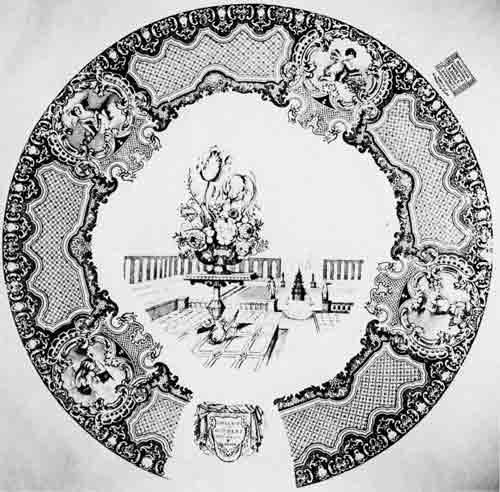
206 Seasons: Italian Garden/April.
|
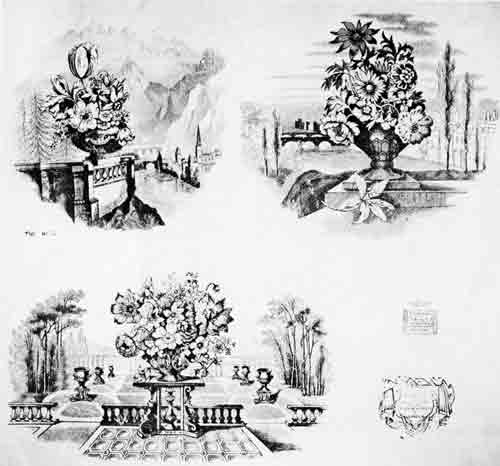
207 Seasons: top left, The Alps/February; top right, unidentified;
bottom, Italian Garden/May.
|
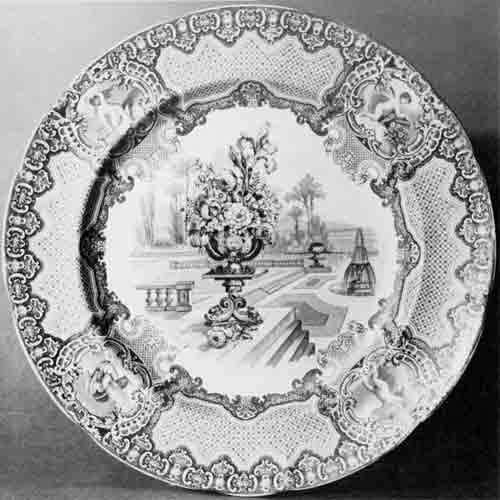
208 Seasons: Italian Garden/June.
|
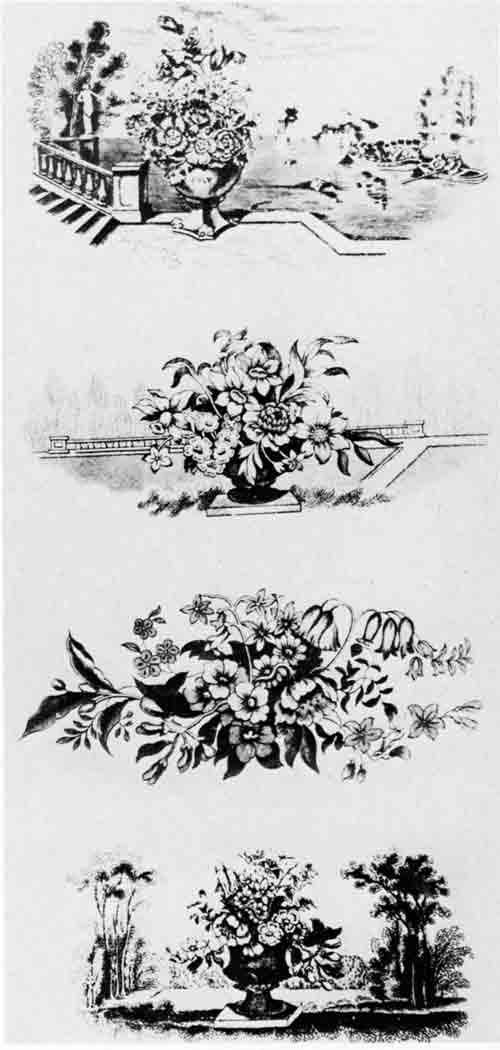
209 Seasons: top left, unidentified scene/July; second from top,
Italian Garden; second from bottom, floral arrangement; bottom,
unidentified.
|
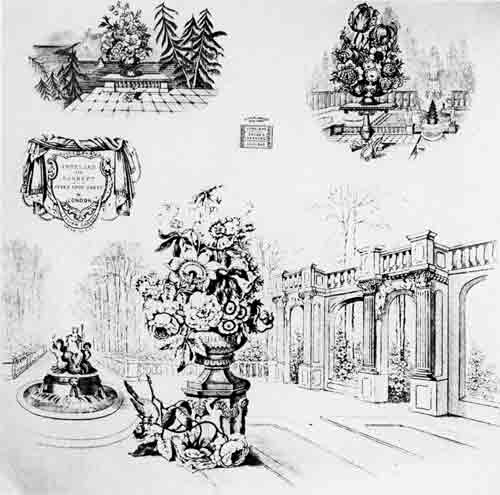
210 Seasons: top left, unidentified scene; top right. Italian Garden;
bottom, Italian Garden/Summer.
|
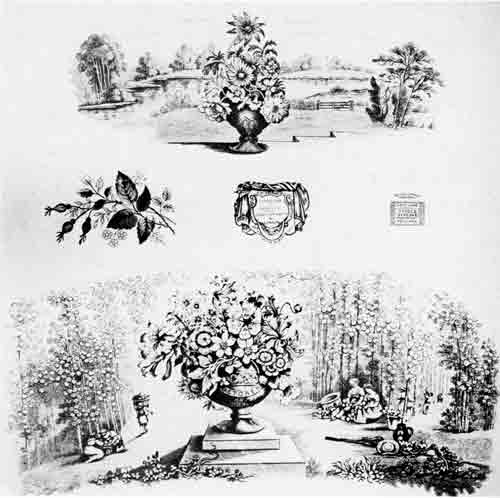
211 Seasons: top, unidentified scene; centre, floral spray; bottom,
unidentified scene/October.
|
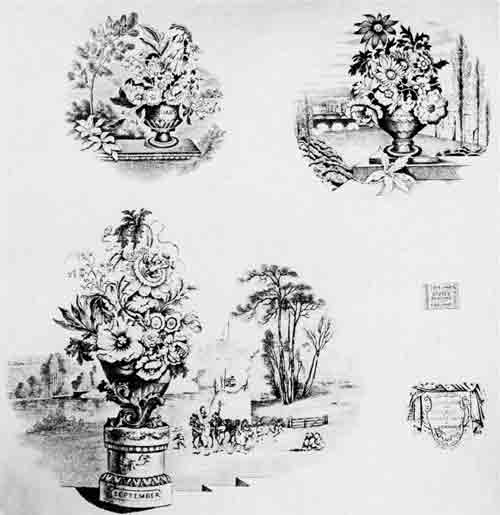
212 Seasons: top left, unidentified scene/January; top right,
unidentified scene/November; bottom. Windsor Castle/September.
|
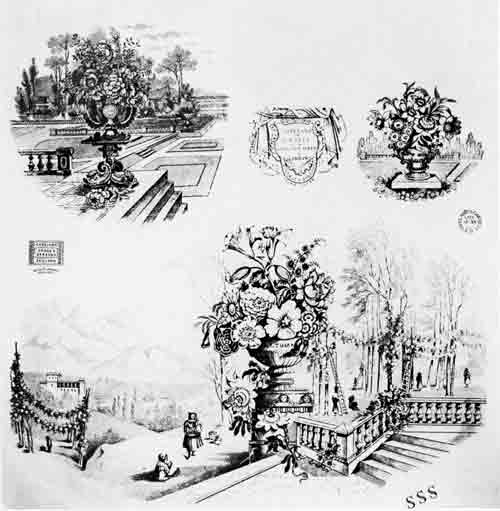
213 Seasons: top left, Italian Garden/June; top right, Italian Garden;
bottom, Vintage of Sorrento/Autumn.
|
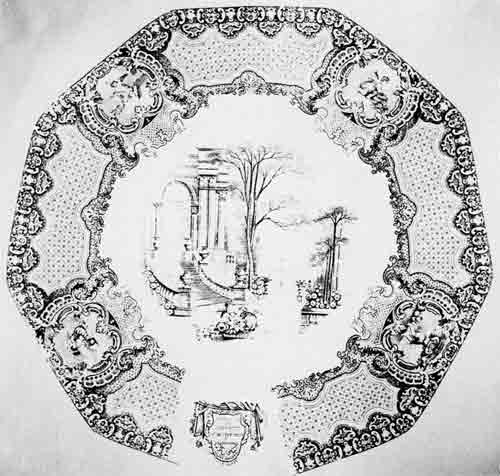
214 Seasons: Italian Garden.
|
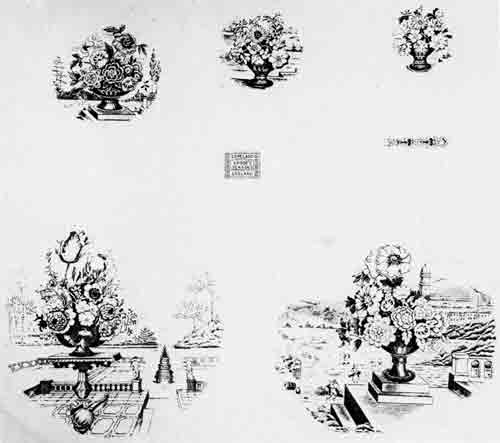
215 Seasons: top three, floral arrangements; centre right, handle
decoration; bottom left, Italian Garden; bottom right, unidentified
scene.
|
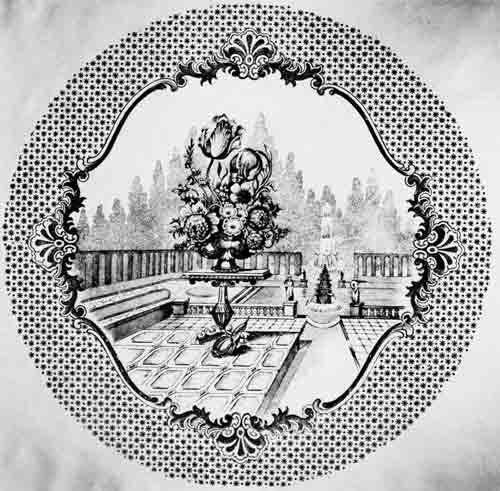
216 Seasons Star (ca. 1836—post-1838).
Earliest pattern number is B473. It has the same centres as Seasons, but
a variation of the Star border. The number "B736" occurs on the copper
plate.
|
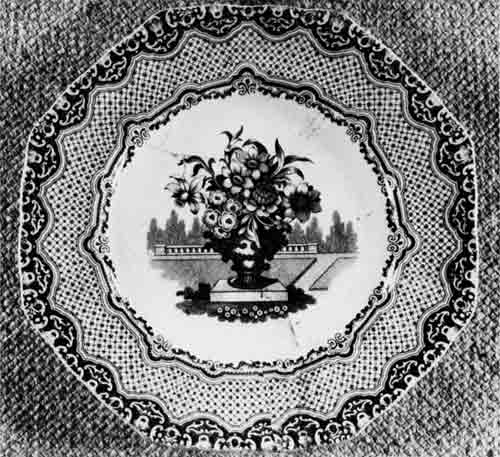
217 Seasons Variation (ca. 1835-?). No known name. It uses the same
motifs as Seasons excepting the reserves of the four seasons in the
border. Excavated examples were made by Copeland and Garrett.
(United States, National Park Service.)
|
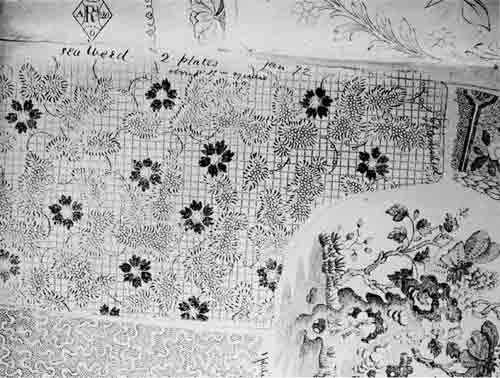
218 Seaweed (pre-1847—post-1872). Introductory date not known.
Excavated examples were made by Copeland and Garrett. A notation
regarding it was made in January 1872 in a factory pattern book,
(Illustration from factory pattern book.) The designs at the top, right
and bottom are not part of the pattern.
|
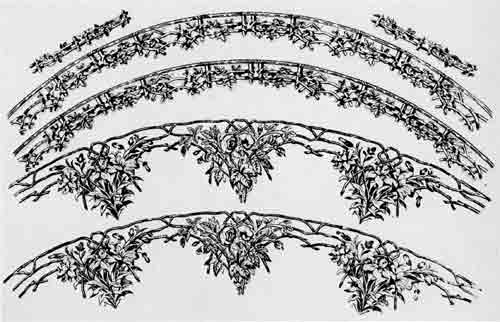
219 7663 (ca. 1842—post-1847). No pattern name has yet been found.
"7663" refers to the earliest pattern number. It is illustrated only in
the china pattern book and has been found only on bone china. The narrow
borders are the same as those on Statice. It was given another number,
8042, about 1815. Excavated examples were made by W.T. Copeland.
|
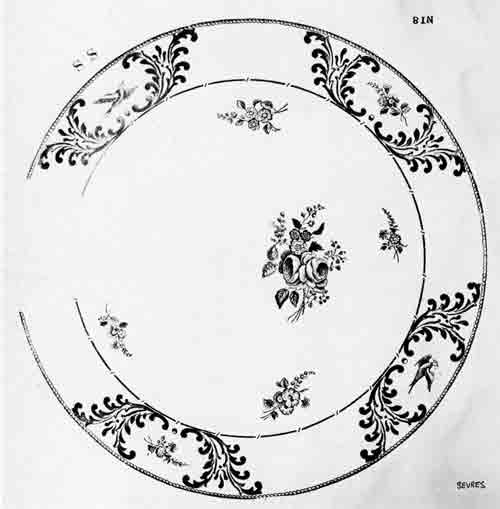
220 Sevres. Manufacturing dates not known. Examples have been retrieved
from sites with a date range from 1824 to 1860. Its centre designs are
the same as those on Rose and Sprigs.
|
221—222 Shagreen (ca. 1834—20th century). Earliest pattern
number is B436. Excavated examples were made by Copeland and Garrett.
Its 20th-century name is "Broth."
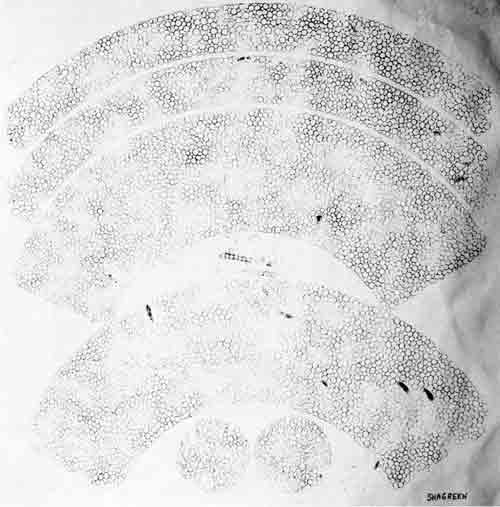
221 Shagreen. The copper plate is badly worn.
|
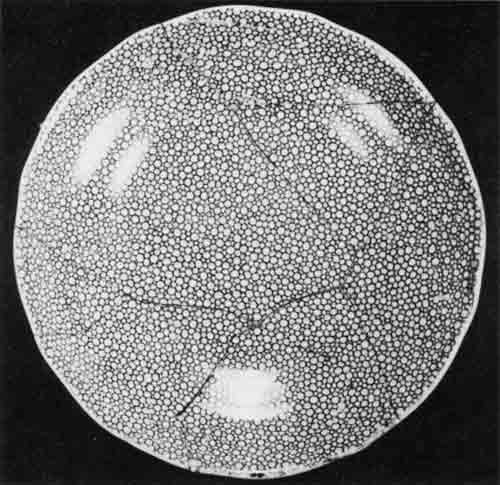
222 Saucer with sheet version of Shagreen.
(United States, National Park Service.)
|
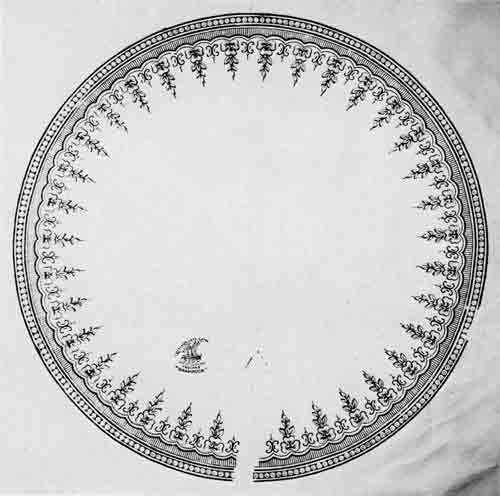
223 Shamrock (1861—1910). Registered 17 September 1861. It appears
in W.T. Copeland and Sons' 1882 catalogue. A mark used between 1894 and
1910 (Godden 1964:172) appears on the copper plate.
|
224—225 Ship Border (ca. 1820-1910). The border is part
of a Spode pattern that was used over many years. Earliest pattern
number is 3025. It was registered in 1884 and, under the name "Bertha,"
in 1894. A mark used between 1894 and 1910 (Godden 1964: 172) appears on
one of the copper plates in conjunction with the 1894 registration
number. It is possible that this mark was introduced earlier than has
been supposed.
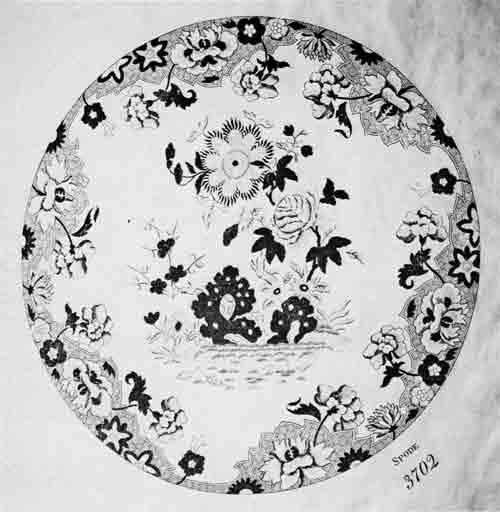
224 Ship border, Star centre.
|
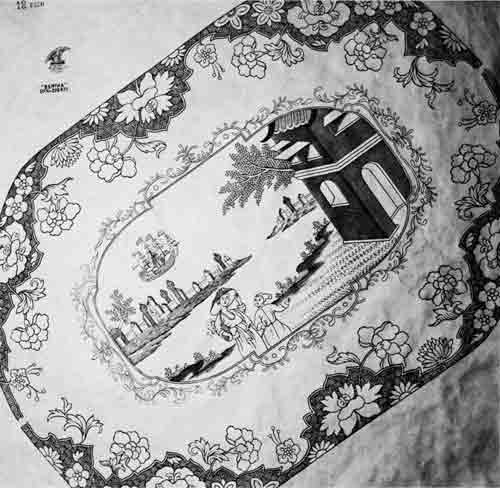
225 Ship border, Berths centre.
|
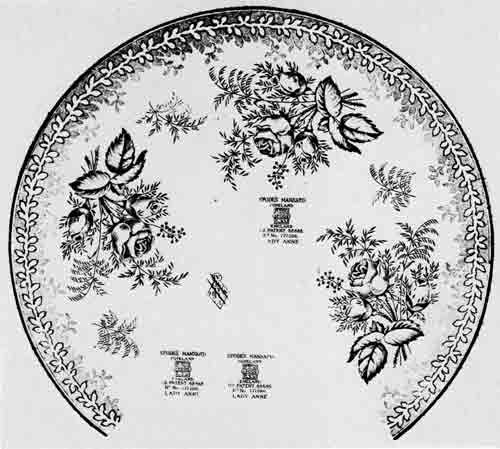
226 Souvenir (1861—20th century).
Registered 18 October 1861. It appears in W.T. Copeland and Sons' 1882
catalogue and seems to have been reserved for toiletware. It was
reregistered in the 20th century under the name "Lady Anne."
|
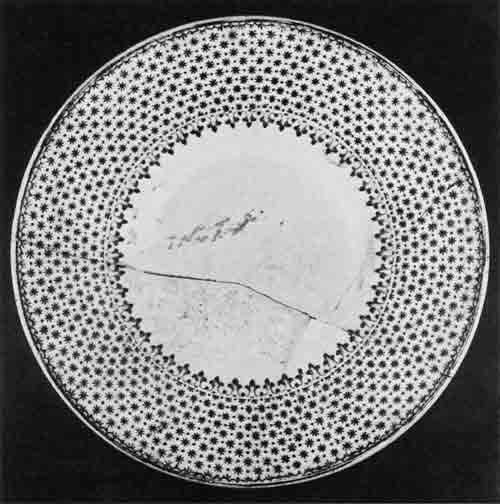
227 Star (pre-1867—?). Introductory date not known. Excavated
examples were made by W.T. Copeland. The Star border with different
beads was used with the centre designs from Seasons to form Seasons
Star.
(Photo by G. Taudien.)
|
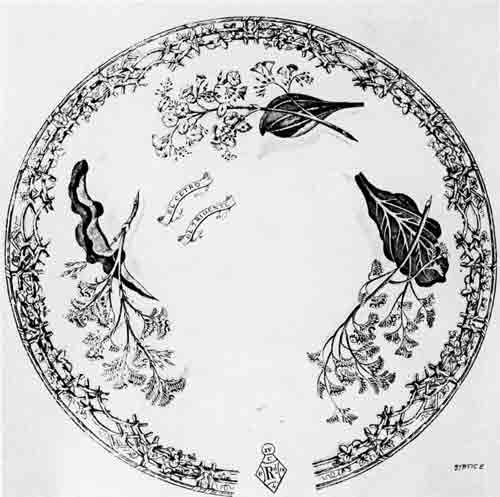
228 Statice (1844—?). Registered 14 October 1844. The border design
is also used on pattern 7663.
|
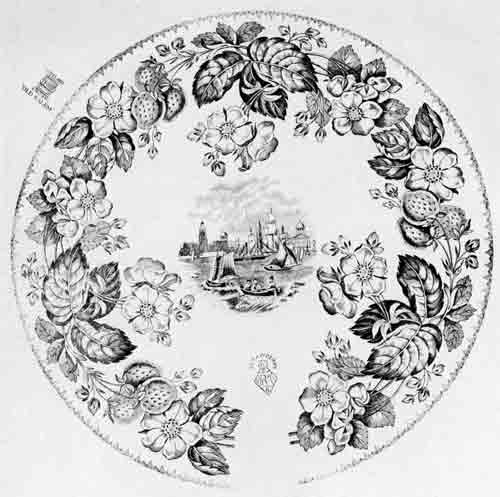
229 Strawberry (1825-20th century). Registered 1 October 1852. Excavated
examples were made by W.T. Copeland and/or W.T. Copeland and Sons. It
appears in W.T. Copeland and Sons' 1882 catalogue. Originally it had no
centre design, but in the 20th century a scenic centre was added and the
name changed to Old Salem.
|
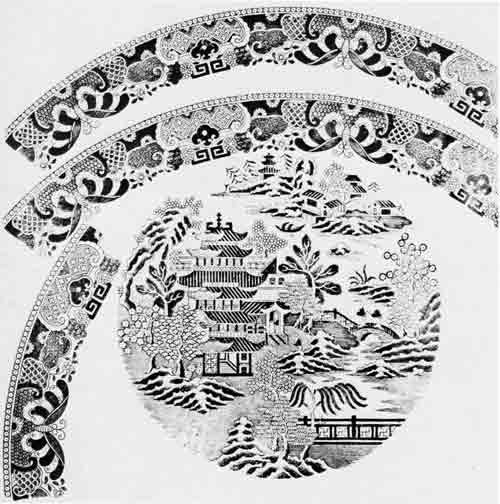
230 Temple. (ca. 1814—?). Introduced
circa 1814 (Whiter 1970: 150). Excavated examples were made by Spode. It
is very similar to the popular Broseley.
|
231—232 Thistle. (ca. 1869—20th century). Earliest
pattern number is D6426. It appears in W.T. Copeland and Sons' 1882
catalogue. A 20th-century mark appears on the copper plate.
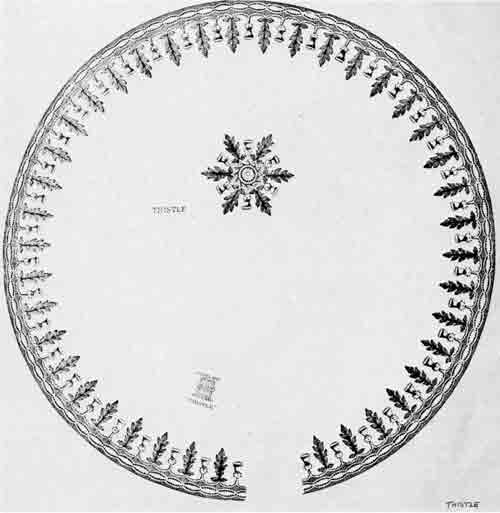
232 Thistle.
|
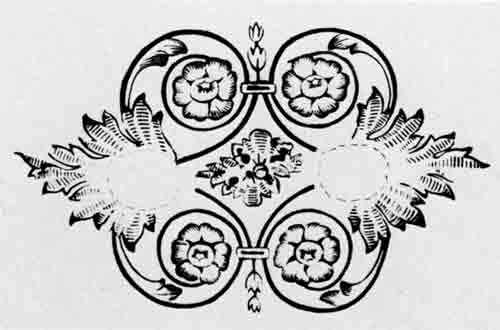
232 Thistle. This design is found superimposed on moulded relief around
handle terminals and on flanged handles. It is also used with Coronal
and probably with other patterns as well.
(Drawing by I. Cameron.)
|
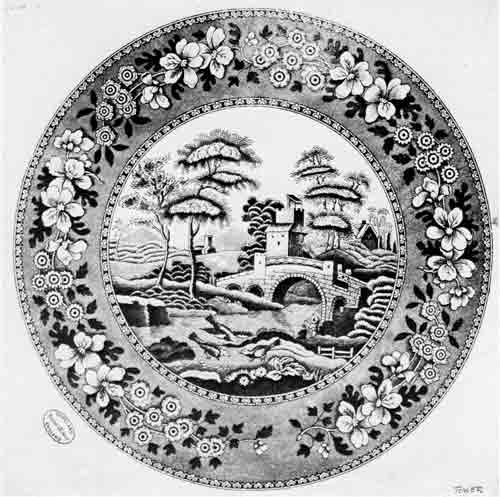
233 Tower (ca. 1819—present). Earliest pattern number for the
border, which is the same as the Milkmaid border, is 3166. Excavated
examples were made by Copeland and Garrett. It is still manufactured by
Spode Limited.
|

234 Turco (1865—post-1882). Earliest pattern number is D4365. It
appears in W.T. Copeland and Sons' 1882 catalogue.
|
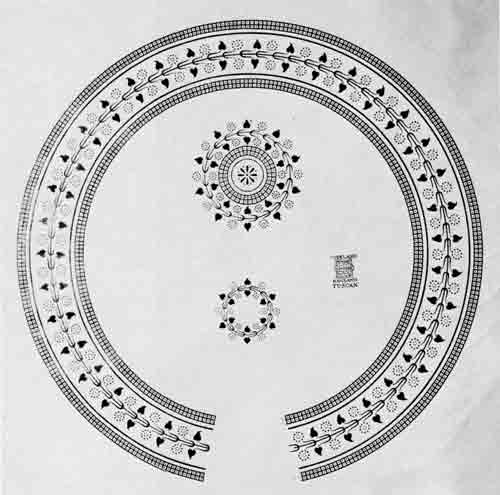
235 Tuscan (1852—20th century). Registered 14 June 1852. It
appears in W.T. Copeland and Sons' 1882 catalogue. A 20th-century mark
occurs on the copper plate.
|
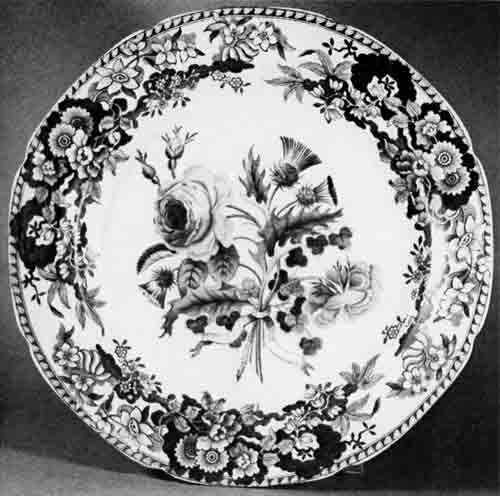
236 Union (ca. 1822—47). Earliest pattern number is 3839. Excavated
examples were made by Copeland and Garrett. Its border is the same as
that on Spode's Girl at Well. About 1825 the central design of Union was
redesigned as a border and called Union Wreath (Whiter 1970:164). For
some reason Union later became known as "Union Wreath, Third."
|
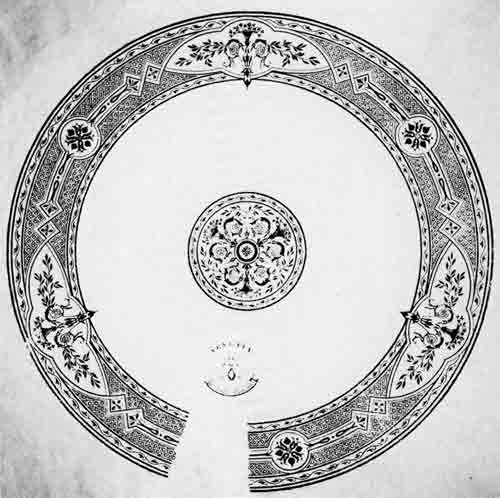
237 Venetia (ca. 1870—post-1882). Earliest pattern number is
D7724. It appears in W.T. Copeland and Sons 1882 catalogue. The mark on
the copper plate was used between 1867 and 1890 (Godden 1964:171).
|
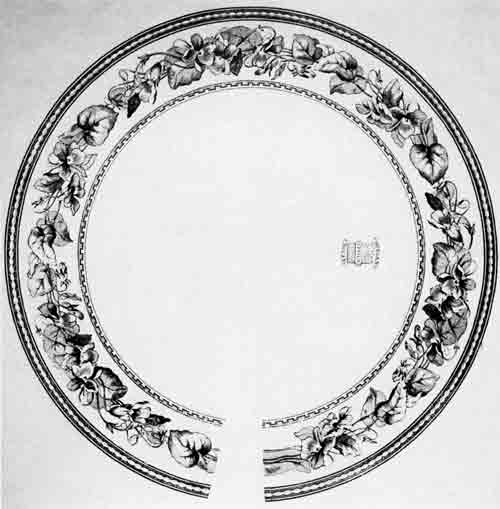
238 Violet (pre-1867—20th century). Introductory date not known.
Excavated examples were made by W.T. Copeland. It appears in W.T.
Copeland and Sons' 1882 catalogue. A 20th-century mark occurs on the
copper plate.
|
239—240 Warwick Groups (pre-1847—20th century).
Introductory date not known. Excavated examples were made by Copeland
and Garrett. A 20th-century mark occurs on one of the copper plates.
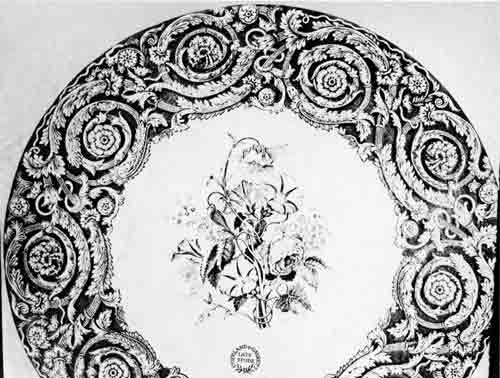
239 Warwick Groups.
|
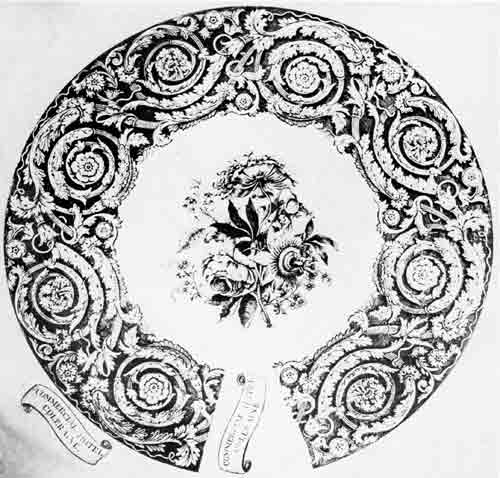
240 Warwick Groups.
|
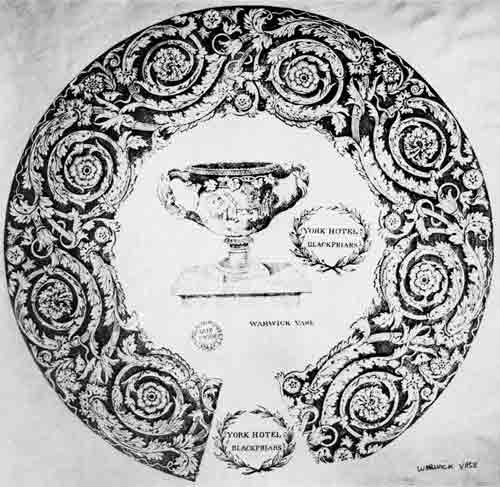
241 Warwick Vase (pre-1847—?). Examples have not been retrieved
in excavations but a fragment of border design could belong equally to
it or Warwick Groups. It predates Warwick Groups and the latter was made
during the Copeland and Garrett period.
A marked Copeland and Garrett Warwick Vase dinner plate is illustrated
in Whiter (1970:171).
|
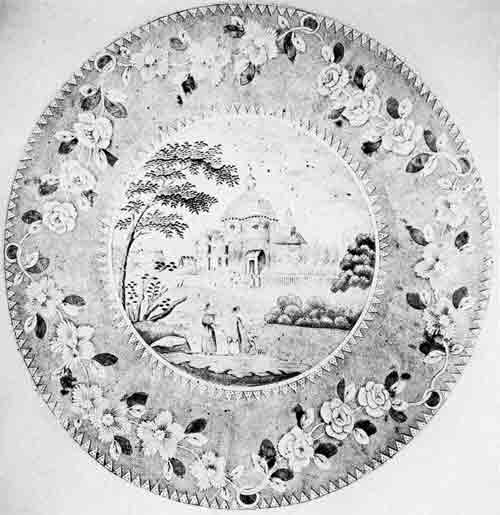
242 Waterloo (ca. 1820—?). Earliest pattern number for border is
3395. Excavated examples were made by Spode, and Copeland and Garrett.
Many authors have referred to it as "Italian Church," but according to
Robert Copeland, the church represented was the church at Waterloo.
|
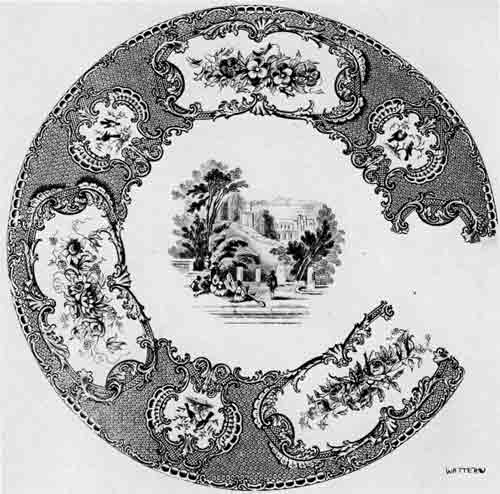
243 Watteau (pre-1847—post-1861). Introductory date not known.
Excavated examples were made by Copeland and Garrett, and W.T. Copeland.
It was given D number 2577 about 1861. On bone china it is called "Queen
Mary."
|
244—246 Wellington (ca. 1839-?). Earliest pattern number is B907.
It is a series of scenes depicting events in the military career of the
Duke of Wellington. A Copeland and Garrett mark appears on one of the
copper plates. The copper plates have been engraved on the back with
another pattern and this plus wear has caused the obliteration of part
of the designs.
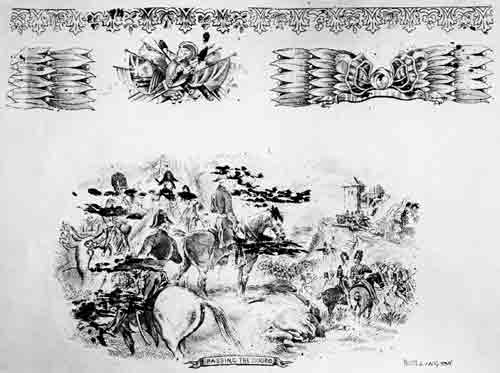
244 Wellington: Passing the Douro.
|
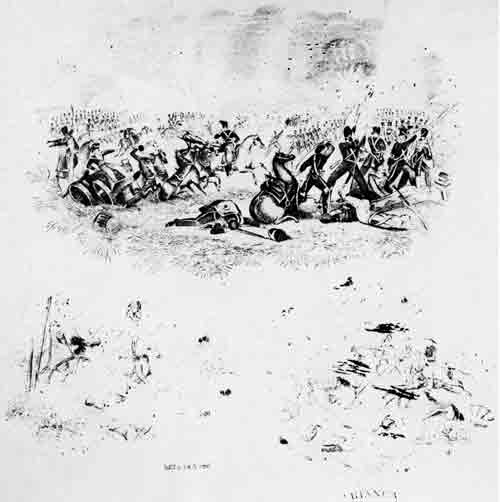
245 Wellington: top, Waterloo (?); bottom left, unidentified; bottom
right, Bianca.
|
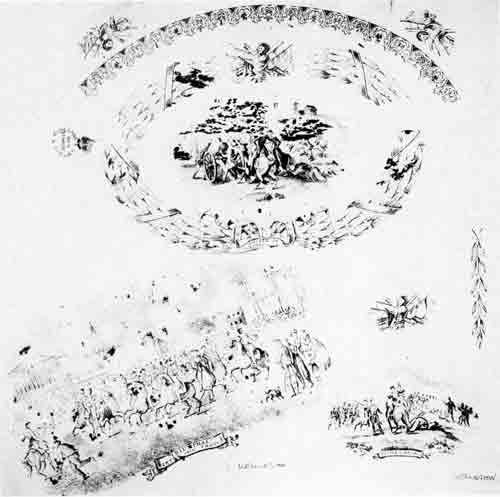
246 Wellington: top, Battle of Fuentes de Oņoro; bottom left, Triumphal
Entry into Paris; bottom right, Battle of Busaco.
|
247—248 Willow (1780s—20th century). This famous
pattern was made from the late 18th century until the 20th century.
Excavated examples were made by Copeland and Garrett.
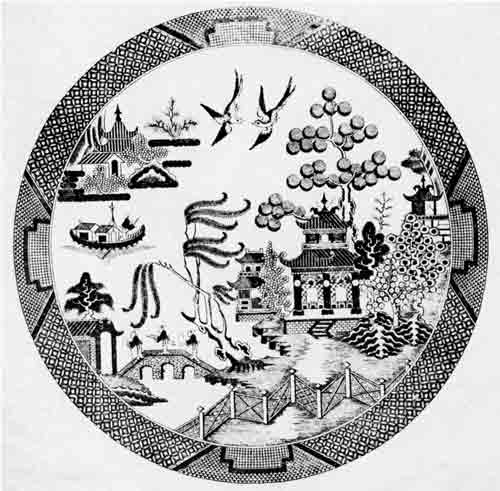
247 Early version of Willow, made by Spode.
|
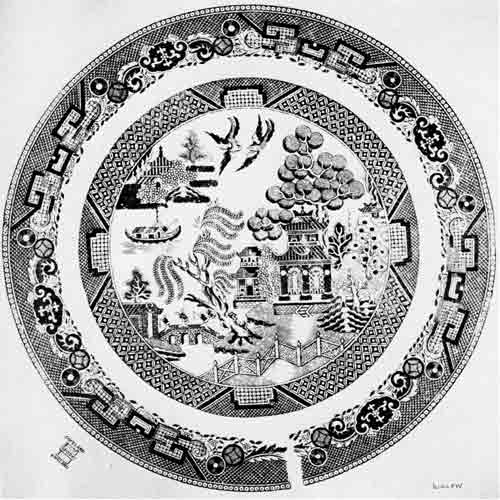
248 Later version of Willow.
|
|

